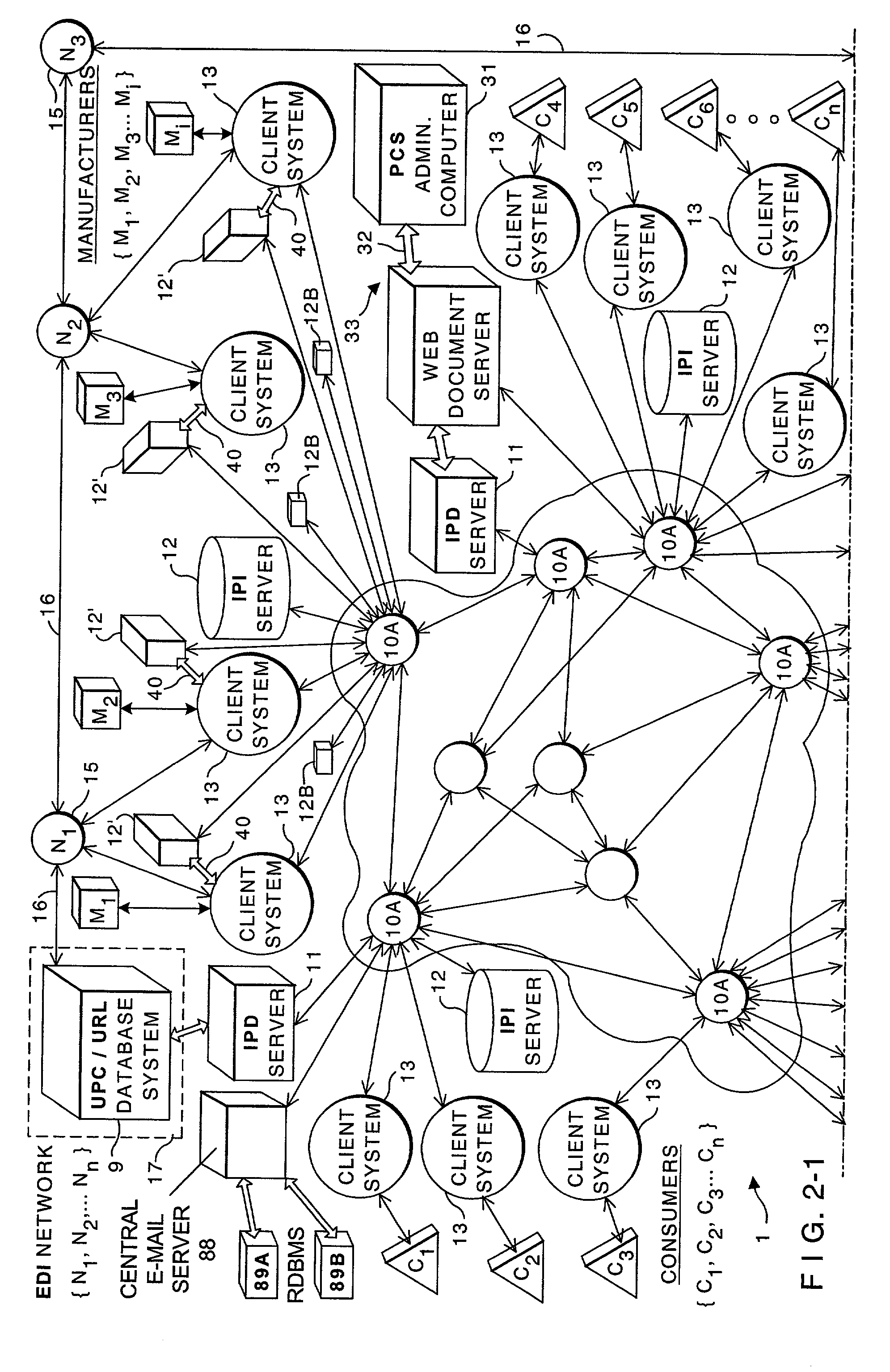[0960] The BRANDKEY REQUEST.TM. CPI search service, accessible through a particular BRANDKEY REQUEST RETAIL.TM. Website or the BRANDKEY REQUEST CENTRAL.TM. Website, enables consumers at home, in the office, on the road, and in retail stores, to quickly access particular types of product-related information which have been published on the WWW by registered manufacturers, their agents and others about consumer products registered with the BRANDKEY REQUEST.TM. RDBMS. BRANDKEY REQUEST.TM. displays such product-related information in a menu-like format organized by particular information types (e.g., Product Advertisements, Product Endorsements,
Product Reviews, Product Rebates and Incentives,
Product Description, Product Manual / Instructions, Product Updates (at FTP Sites), Product Returns, Warranty and Repair Service, Direct Product Purchase, Retailers, Wholesalers, Complementary Products, Company Annual Report, Stock Purchase, etc.). Each displayed information menu associated with a consumer product contains hyper-linked URLs pointing to
HTML-documents containing particular types of product-related information linked to the product by the manufacturer or its agent.
[0962] TRADE-MARK.TM. CPI search service, accessible through a particular BRANDKEY REQUEST.TM. Retail Website or the BRANDKEY REQUEST.TM. Central Website, enables consumers to quickly access particular types of product-related information from the BRANDKEY REQUEST.TM.
Database, by using the
trademark or
trade name of the related product. When this mode of service is requested, a search screen is displayed within the information frame so that the consumer or sales clerk can enter the
trademark or
trade name for the related consumer product.
[0963] PRODUCT-TYPE.TM. CPI search service, accessible through a particular BRANDKEY REQUEST RETAIL.TM. Website or the BRANDKEY REQUEST CENTRAL.TM. Website, enables consumers to quickly access particular types of product-related information from the BRANDKEY REQUEST.TM.
Database, by using a descriptive term for the related product. When this mode of service is requested, a search screen is displayed within the information frame so that the consumer or sales clerk can enter a descriptive term for the related consumer product.
[0973] In the first and second
modes of operation, in a split-screen structure 300 as shown in FIG. 2E1 is displayed, wherein the first (e.g. left) side document frame 301 contains information relating to a particular
Web document and has an independent scroll bar 302 within a 304B windows-type GUI-based
data structure, and wherein second (e.g. right) side document frame 303 contains information relating to a particular print-media document and has an independent scroll bar 304 within a windows-type GUI-based
data structure. By providing such a split-screen display screen GUIs in both of these
modes of operation, the publishing
software program of the present invention enables the author to independently scroll literary and graphical context in the
Web document frame 301 of the GUI, and the print-media document frame 303 thereof, thereby facilitating alignment of corresponding sections during both the composition / editorial mode of operation as well as during the UPN / TM / PD / URL
data linking mode of operation.
[0977] The above-described publishing
software program will have great value in publishing applications where both Web and print-media versions of documents, articles and the like are simultaneously published on the WWW and in the world of print-media, as in the case of many newspapers, magazines, journals, subscriptions, product discount flyers, and the like. In such instances, each publication will have numerous "Sections" or "Parts", classified by the type of
subject matter being addressed, and contributed to by authors and composers from categorically different departments (e.g. business, sports, world news, local news, arts and entertainment, technology, etc.). Thus, in such instances, a "
client" copy of the publishing program of the present invention discussed above will run on different
client computing subsystems on the LAN or WAN of the publisher, as shown in FIG. 2D, while a "
server" copy runs on at least one
client computing subsystem on the LAN or WAN. Such a client-
server solution enables an editorial manager to oversee the entire Web / print-media publication process, while individual writers are permitted to labor on their literary and graphical art assignments, whatever they may be. In short, the novel publishing tools and methods of the present invention have now made linking the worlds of electronic and print-media simple, efficient and reliable.
[0984] Notably, by using the EDI-based UPN / TM / PD / URL
data link management and serving techniques of the present invention, described in great detail hereinabove, publishers of print-media based products can quickly update the UPN / TM / PD / URL RDBMS 9 to contain current UPN / TM / PD / URL links created only minutes before hand in the back-offices of the publishing firm (e.g. just after final approval by the chief editor assigned to a particular print-media publication). This enables consumers to automatically link to related URLs at the
time distribution of the print publication, using Web-enabled client subsystems 13 in accordance with the principles of the present invention.Modifications of and Extensions to the
System and Method of the Present Invention to Provide an Integrated
 Login to View More
Login to View More  Login to View More
Login to View More 


